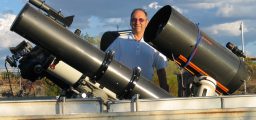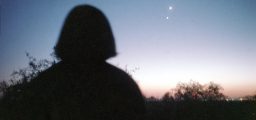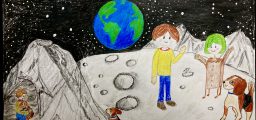From frustration to jubilation: A planetary conjunction story

From frustration to jubilation: A planetary conjunction story
By Paul Levesque
NASA estimates that, at any given time, about two-thirds of Earth’s surface is covered by clouds. In her 1968 hit tune, “Both Sides Now,” Joni Mitchell sang, “So many things I would have done / But clouds got in my way.”
I believe I speak for all amateur astronomers when I say, “NASA, we believe you, and Joni, we hear you.” Clouds have spoiled many a planned astronomy event, and even a somewhat hopeful weather forecast of “Partly Cloudy” has often turned out to mean, “Cloudy at the worst possible time in the worst possible part of the sky.”
But it isn’t cloudy all the time, and the frustration we feel when clouds roll in is often followed by the jubilation felt when the sky clears and the observation we were hoping to make pops into sight.
Such was my experience with clouds during the December 2020 conjunction of Jupiter and Saturn, a true once-in-a-lifetime event which I simply did not want to miss. The conjunction, which built to a climax over time as the planets moved closer together from our vantage point, was scheduled to peak on December 21, a date on which we would be out of town, visiting my wife’s sister and her family in Lake Forest, Illinois, located near Lake Michigan north of Chicago and right by old Fort Sheridan.
We arrived on December 20, a Sunday, and as the sun went down that evening I went out on my own, seeking a view of the conjunction. There is a relatively dark bike path located near my sister-in-law’s home and I walked there, looking up at a bright half-moon, knowing that the planets would appear somewhere between it and the sun, now below the horizon but still glowing in the southwest.
Also off to the west were some clouds, moving eastward, but not yet to where I thought the conjunction would appear. I walked along, looked to the left of the moon – further up the ecliptic – and saw Mars emerge, bright and reddish high in the darkening sky. Jupiter and Saturn could not be far behind.
Minutes passed, and then I saw it, about halfway between the moon and the horizon – Jupiter! Its companion, Saturn, still could not be seen – but what I could see was a bank of dark grey clouds, moving in exactly the wrong direction. Seconds later, Jupiter was covered in a cloudbank, before I could get a view of its companion planet. No conjunction! Frustrating indeed.
There was no hope of seeing the conjunction or anything else the next night – the peak conjunction night – as clouds completely covered the sky. But the sun was shining when we left for Moline on Tuesday the 22nd, and the evening forecast for the Quad Cities called for – you guessed it – “partly cloudy” skies.
It was still sunny and mild with a light breeze when we got home in the early afternoon, perfect viewing conditions, but would they hold until sunset? I kept an eye on the sky out the window as the sun moved lower – looking clear, looking good!
Soon after 5 p.m., I set out for Jefferson School in Moline. There is a large grass field right by the school which offers an unobstructed view pretty much from horizon to horizon, making it one of the best observing sites you’ll find anywhere within the metro Quad Cities.
This field was apparently once part of the Oakwood Country Club golf course, which moved to Coal Valley in the 1960s due to the construction of a nearby interstate highway. In the early years of the Popular Astronomy Club, public viewings were held on this very spot, until Oakwood members put a stop to them due to fear that the fairways would be damaged.
I’d gone to this field a few weeks before, in the predawn hours, in hopes of catching a glimpse of the Geminid meteor shower. Though the sky was clear, no shooting stars appeared that morning; now, this evening, would the conjunction appear?
Yes! There is was, as clear as it could be, Jupiter the brighter and larger object, with Saturn just a little below and ahead of it, separated by a tiny sliver of sky. Truly a beautiful sight, viewed from ground where amateur astronomers had looked at similar phenomena decades before. I couldn’t help but feel connected.
I took my recently acquired iPhone 12, pointed it at the planetary conjunction, and took a picture. It looked merely like a point of light on my phone’s screen, so I wasn’t expecting much.
When I got home and downloaded the photo, though, I saw that it had captured the separation between the planets, and that it showed both as distinct round disks. I was truly amazed, more at the capabilities of the phone than at my own amateurish photographic skills.
I am sharing this photo with all of you, knowing that millions of photos of the conjunction were probably taken worldwide, that much better photos were probably taken by members of this club, and that my photo ranks in the lowest percentile by any possible measure.
And yet I find myself constantly looking at this photo, admiring not my own handiwork but the handiwork of the sky above us, which has and always will inspire awe and wonder in those of us who choose to look up. That’s why we do what we do, and why clouds will never stop us.




Comments are closed.